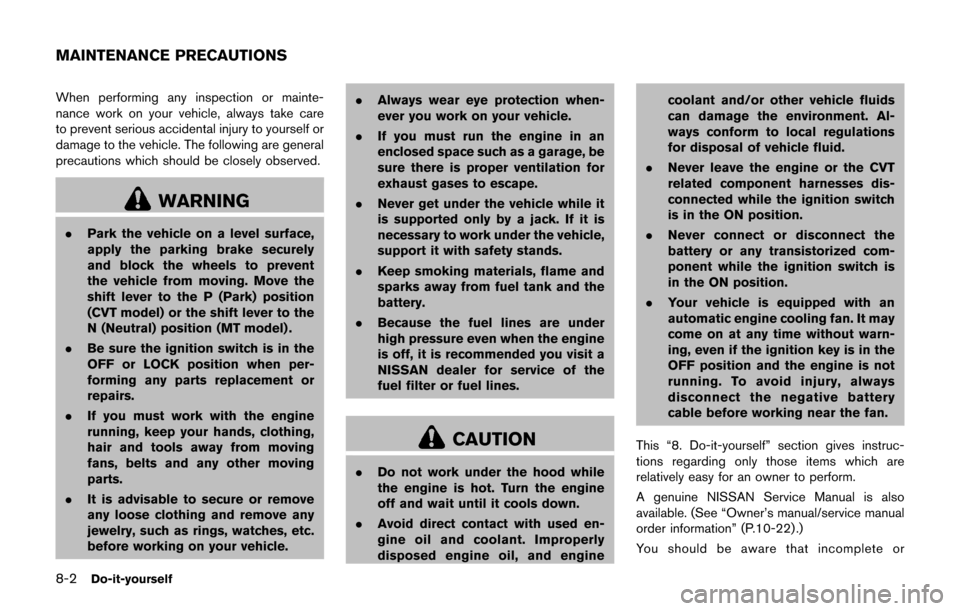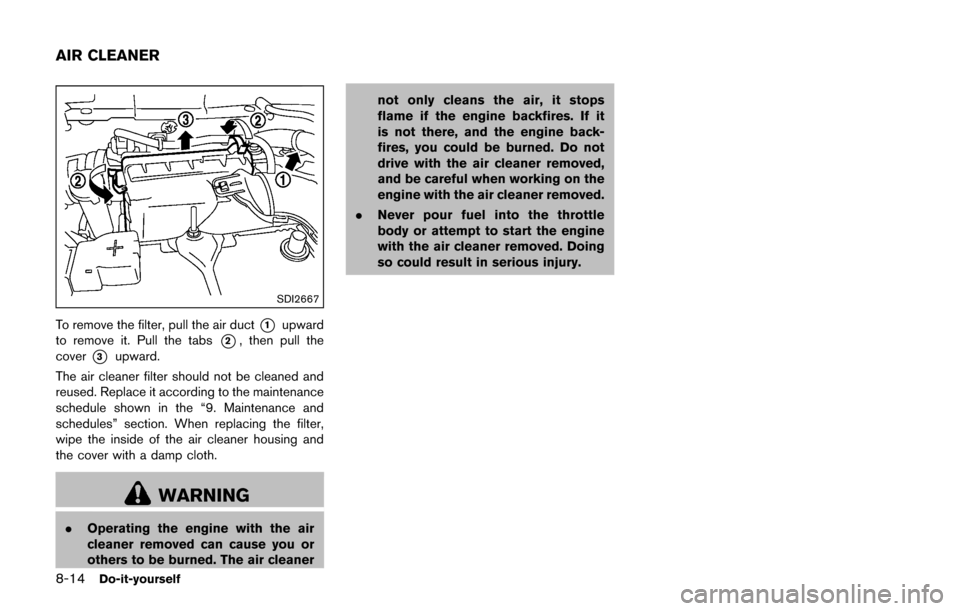2017 NISSAN JUKE fuel filter
[x] Cancel search: fuel filterPage 290 of 416

.Keep your engine tuned up.
. Follow the recommended scheduled main-
tenance.
. Keep the tires inflated to the correct
pressure. Low tire pressure increases tire
wear and lowers fuel economy.
. Keep the wheels in correct alignment.
Improper alignment increases tire wear and
lowers fuel economy.
. Use the recommended viscosity engine oil.
(See “Engine oil and oil filter recommenda-
tion” (P.10-7) .)
WARNING
.For AWD equipped vehicles, do not
attempt to raise two wheels off the
ground and shift the transmission to
any drive or reverse position with
the engine running. Doing so may
result in drivetrain damage or un-
expected vehicle movement which
could result in serious vehicle da-
mage or personal injury.
. Do not attempt to test an AWD
equipped vehicle on a 2-wheel dy-
namometer (such as the dynam-
ometers used by some states for
emissions testing) or similar equip-
ment even if the other two wheels
are raised off the ground. Make sure
that you inform the test facility
personnel that your vehicle is
equipped with AWD before it is
placed on a dynamometer. Using
the wrong test equipment may re-
sult in drivetrain damage or unex-
pected vehicle movement which
could result in serious vehicle da-
mage or personal injury.
SSD1129
AWD mode switch
ALL-WHEEL DRIVE (AWD) MODE
SWITCH OPERATIONS
The All-Wheel Drive (AWD) system is used to
select the 2WD (Two-Wheel Drive) , AWD-V or
AWD mode depending on the driving condi-
tions.
The AWD mode indicator lights (
(green) ,) are located in the instrument panel.
The AWD mode indicator lights
(green)
illuminate when the ignition switch is placed in
the ON position. The indicator lights turn off
within 1 second.
The AWD mode indicator lights will display the
mode selected by the AWD mode switch while
Starting and driving5-29
INCREASING FUEL ECONOMY ALL-WHEEL DRIVE (AWD) (if so
equipped)
Page 327 of 416

8-2Do-it-yourself
When performing any inspection or mainte-
nance work on your vehicle, always take care
to prevent serious accidental injury to yourself or
damage to the vehicle. The following are general
precautions which should be closely observed.
WARNING
.Park the vehicle on a level surface,
apply the parking brake securely
and block the wheels to prevent
the vehicle from moving. Move the
shift lever to the P (Park) position
(CVT model) or the shift lever to the
N (Neutral) position (MT model) .
. Be sure the ignition switch is in the
OFF or LOCK position when per-
forming any parts replacement or
repairs.
. If you must work with the engine
running, keep your hands, clothing,
hair and tools away from moving
fans, belts and any other moving
parts.
. It is advisable to secure or remove
any loose clothing and remove any
jewelry, such as rings, watches, etc.
before working on your vehicle. .
Always wear eye protection when-
ever you work on your vehicle.
. If you must run the engine in an
enclosed space such as a garage, be
sure there is proper ventilation for
exhaust gases to escape.
. Never get under the vehicle while it
is supported only by a jack. If it is
necessary to work under the vehicle,
support it with safety stands.
. Keep smoking materials, flame and
sparks away from fuel tank and the
battery.
. Because the fuel lines are under
high pressure even when the engine
is off, it is recommended you visit a
NISSAN dealer for service of the
fuel filter or fuel lines.
CAUTION
.Do not work under the hood while
the engine is hot. Turn the engine
off and wait until it cools down.
. Avoid direct contact with used en-
gine oil and coolant. Improperly
disposed engine oil, and engine coolant and/or other vehicle fluids
can damage the environment. Al-
ways conform to local regulations
for disposal of vehicle fluid.
. Never leave the engine or the CVT
related component harnesses dis-
connected while the ignition switch
is in the ON position.
. Never connect or disconnect the
battery or any transistorized com-
ponent while the ignition switch is
in the ON position.
. Your vehicle is equipped with an
automatic engine cooling fan. It may
come on at any time without warn-
ing, even if the ignition key is in the
OFF position and the engine is not
running. To avoid injury, always
disconnect the negative battery
cable before working near the fan.
This “8. Do-it-yourself” section gives instruc-
tions regarding only those items which are
relatively easy for an owner to perform.
A genuine NISSAN Service Manual is also
available. (See “Owner’s manual/service manual
order information” (P.10-22) .)
You should be aware that incomplete or
MAINTENANCE PRECAUTIONS
Page 339 of 416

8-14Do-it-yourself
SDI2667
To remove the filter, pull the air duct*1upward
to remove it. Pull the tabs
*2, then pull the
cover
*3upward.
The air cleaner filter should not be cleaned and
reused. Replace it according to the maintenance
schedule shown in the “9. Maintenance and
schedules” section. When replacing the filter,
wipe the inside of the air cleaner housing and
the cover with a damp cloth.
WARNING
. Operating the engine with the air
cleaner removed can cause you or
others to be burned. The air cleaner not only cleans the air, it stops
flame if the engine backfires. If it
is not there, and the engine back-
fires, you could be burned. Do not
drive with the air cleaner removed,
and be careful when working on the
engine with the air cleaner removed.
. Never pour fuel into the throttle
body or attempt to start the engine
with the air cleaner removed. Doing
so could result in serious injury.
AIR CLEANER
Page 372 of 416

The following descriptions are provided to give
you a better understanding of the scheduled
maintenance items that should be regularly
checked or replaced. The maintenance sche-
dule indicates at which mileage/time intervals
each item requires service.
In addition to scheduled maintenance, your
vehicle requires that some items be checked
during normal day-to-day operation. Refer to
“General maintenance” (P.9-2) .
Items marked with “*” are recommended by
NISSAN for reliable vehicle operation. You are
not required to perform maintenance on these
items in order to maintain the warranties which
come with your vehicle. Other maintenance
items and intervals are required.
When applicable, additional information can be
found in the “8. Do-it yourself” section of this
manual.
NOTE:
NISSAN does not advocate the use of non-
OEM approved aftermarket flushing sys-
tems and strongly advises against per-
forming these services on a NISSAN
product. Many of the aftermarket flushing
systems use non-OEM approved chemicals
or solvents, the use of which has not been
validated by NISSAN.For recommended fuel, lubricants, fluids,
grease, and refrigerant, refer to
“Capaci-
ties and recommended fluids/lubricants”
(P.10-2) of this manual.
EMISSION CONTROL SYSTEM MAIN-
TENANCE
Drive belts*:
Check engine drive belts for wear, fraying or
cracking and for proper tension. Replace any
damaged drive belts.
Engine air filter:
Replace at specified intervals. When driving for
prolonged periods in dusty conditions, check/
replace the filter more frequently.
Engine coolant*:
Replace coolant at the specified interval. When
adding or replacing coolant, be sure to use only
Genuine NISSAN Long Life Antifreeze/Coolant
(blue) or equivalent with the proper mixture.
(Refer to “Engine cooling system” (P.8-4) to
determine the proper mixture for your area.)
NOTE:
Mixing any other type of coolant or the use
of non-distilled water may reduce the
recommended service interval of the cool-
ant. Engine oil and oil filter:
Replace engine oil and oil filter at the specified
intervals. For recommended oil grade and vis-
cosity refer to “Capacities and recommended
fluids/lubricants” (P.10-2) .
Engine valve clearance*:
Inspect only if valve noise increases.
Adjust valve clearance if necessary.
Evaporative emissions control vapor
lines*:
Check vapor lines for leaks or looseness.
Tighten connections or replace parts as neces-
sary.
Fuel filter
Periodic maintenance is not required (in-tank
type filter) .
Fuel lines*:
Check the fuel hoses, piping and connections
for leaks, looseness, or deterioration. Tighten
connections or replace parts as necessary.
Spark plugs:
Replace at specified intervals. Install new plugs
of the type as originally equipped.
Maintenance and schedules9-5
EXPLANATION OF SCHEDULED
MAINTENANCE ITEMS
Page 375 of 416

9-8Maintenance and schedules
EMISSION CONTROL SYSTEM MAINTENANCE
Abbreviations: I = Inspect and correct or replace as necessary, R = Replace
MAINTENANCE OPERATION
Perform at number of miles, kilo-
meters or months, whichever
comes first.Miles
61,000
(km 61,000)
Months MAINTENANCE INTERVAL
5
(8) 6 10
(16) 12 15
(24) 18 20
(32) 24 25
(40) 30 30
(48) 36 35
(56) 42 40
(64) 48 45
(72) 54 50
(80) 60 55
(88) 66 60
(96) 72
Drive belts See NOTE (1) I*I* I*
Air cleaner filter See NOTE (2) RR
EVAP vapor lines I*I* I*
Fuel lines I*I* I*
Fuel filter See NOTE (3)
Engine coolant* See NOTE (4)(5)
Engine oil R R R R R R R R R R R R
Engine oil filter R R R R R R R R R R R R
Spark plugs See NOTE (6) Replace every 105,000 miles (168,000 km)
Intake and exhaust valve clear-
ance* See NOTE (7)
Page 376 of 416

MAINTENANCE OPERATION
Perform at number of miles,
kilometers or months, whichever
comes first.Miles
61,000
(km 61,000)
Months MAINTENANCE INTERVAL
65
(104) 78 70
(112) 84 75
(120) 90 80
(128) 96 85
(136) 102 90
(144) 108 95
(152) 114 100
(160) 120 105
(168) 126 110
(176) 132 115
(184) 138 120
(192) 144
Drive belts See NOTE (1)I*I*I*I* I* I*
Air cleaner filter See NOTE (2) RR
EVAP vapor lines I*I* I*
Fuel lines I*I* I*
Fuel filter See NOTE (3)
Engine coolant* See NOTE (4)(5)
Engine oil R R R R R R R R R R R R
Engine oil filter R R R R R R R R R R R R
Spark plugs See NOTE (6) Replace every 105,000 miles (168,000 km)
Intake and exhaust valve clear-
ance* See NOTE (7)
Maintenance and schedules9-9
Page 386 of 416

10 Technical and consumer information
Capacities and recommended fluids/lubricants ............. 10-2Fuel information ................................................................ 10-4
Engine oil and oil filter recommendation .................... 10-7
Air conditioning system refrigerant and
lubricant recommendations ............................................ 10-8
Specifications ........................................................................\
.. 10-9
Engine ........................................................................\
......... 10-9
Wheels and tires .............................................................. 10-9
Dimensions and weights ............................................. 10-10
When traveling or registering in another country ....... 10-10
Vehicle identification ........................................................... 10-11 Vehicle Identification Number (VIN) plate ............... 10-11
Vehicle identification number (chassis number) .... 10-11
Engine serial number .................................................... 10-11
F.M.V.S.S./C.M.V.S.S. certification label ................. 10-12
Emission control information label ............................ 10-12
Tire and Loading Information label ........................... 10-12
Air conditioner specification label ............................. 10-13
Installing front license plate .............................................. 10-13 Vehicle loading information .............................................. 10-15
Terms ........................................................................\
...... 10-15
Vehicle load capacity ................................................. 10-15
Loading tips .................................................................. 10-17
Measurement of weights ........................................... 10-17
Towing a trailer .................................................................... 10-18
Flat towing ........................................................................\
.... 10-18 Continuously Variable Transmission (CVT) .......... 10-18
Manual Transmission .................................................. 10-18
Uniform tire quality grading .............................................. 10-19
Treadwear ..................................................................... 10-19
Traction AA, A, B and C ........................................... 10-19
Temperature A, B and C ........................................... 10-19
Emission control system warranty .................................. 10-20
Reporting safety defects .................................................. 10-20
Readiness for Inspection/Maintenance (I/M) test ...... 10-21
Event Data Recorders (EDR) .......................................... 10-22
Owner’s manual/service manual order information ..... 10-22
Page 387 of 416

10-2Technical and consumer information
The following are approximate capacities. The actual refill capacities may be a little different. When refilling, follow the procedure
instructed in the “8. Do-it-yourself” section to determine the proper refill capacity.
Fluid typeCapacity (Approximate)
Recommended Fluids/Lubricants
Metric
Measure US
Measure Imperial
Measure
Fuel 2WD model 50 13-1/4 gal 11 gal�ÂSee “Fuel information” (P.10-4).
AWD model 45 11-7/8 gal 9-7/8 gal
Engine oil
*1With oil filter change For NISMO RS model 4.3 4-1/2 qt 3-3/4 qt For NISMO RS models
�ÂGenuine “Nissan Motor Oil 5W-30 SN” is recommended.
� If the above motor oil is not available, use an equivalent motor oil that matches the above
grade and viscosity. For additional information, see “Engine oil and oil filter recommendation”
(P.10-7).
Except for NISMO RS models
�ÂGenuine “Nissan Motor Oil 0W-20 SN” is recommended.
� If the above motor oil is not available, use an equivalent motor oil that matches the above
grade and viscosity. For additional information, see “Engine oil and oil filter recommendation”
(P.10-7).
Drain and refill
*1: For additional in-
formation, see
“Changing engine
oil and filter” (P.8-6). Except for NISMO RS model 4.5 4-3/4 qt 4 qt
Without oil filter
change For NISMO RS model
4.1 4-3/8 qt 3-5/8 qt
Except for NISMO RS model 4.3 4-1/2 qt 3-3/4 qt
Engine coolant With reservoir For NISMO RS modelCVT model 8.1 8-5/8 qt 7-1/8 qt
�ÂPre-diluted Genuine NISSAN Long Life Antifreeze/Coolant (blue) or equivalent
MT model 7.9 8-3/8 qt 7 qt
Except for
NISMO RS
model CVT model 8.7 9-1/4 qt 7-5/8 qt
MT model 8.5 8-3/8 qt 7 qt
Reservoir 0.6 5/8 qt 1/2 qt
Continuously Variable Transmission (CVT) fluid — — — For NISMO RS models
�ÂGenuine NISSAN CVT Fluid NS-2
� NISSAN recommends using Genuine NISSAN CVT Fluid NS-2 (or equivalent) ONLY in
NISSAN CVTs. Do not mix with other fluids. Using fluids that are not equivalent to Genuine
NISSAN CVT Fluid NS-2 may damage the CVT. Damage caused by the use of fluids other
than as recommended is not covered under NISSAN’s New Vehicle Limited Warranty.
Except for NISMO RS models
�ÂGenuine NISSAN CVT Fluid NS-3
� NISSAN recommends using Genuine NISSAN CVT Fluid NS-3 (or equivalent) ONLY in
NISSAN CVTs. Do not mix with other fluids. Using fluids that are not equivalent to Genuine
NISSAN CVT Fluid NS-3 may damage the CVT. Damage caused by the use of fluids other
than as recommended is not covered under NISSAN’s New Vehicle Limited Warranty.
CAPACITIES AND RECOMMENDED
FLUIDS/LUBRICANTS